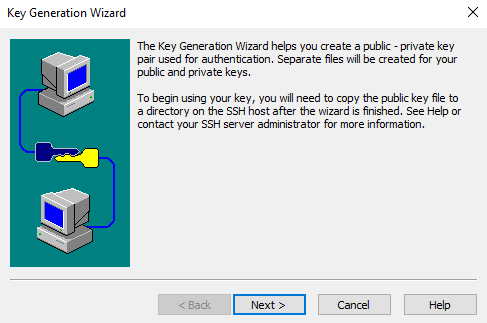

The server then records this public key in a list of authenticated clients and assigns it an ID. First, the client must register with the server by sending the client’s public key to the server. Running as a container, Pythonic exposes two TCP ports: TCP port 7000 (main editor) and TCP port 8000 (the code-server source-code editor).SSH uses public-key encryption to ensure that a client is who it claims to be.
#LINUX SSH KEYGEN RSA2 SOFTWARE#
I will demonstrate this procedure with my software project Pythonic. But SSH makes it relatively easy to set up a safe solution for this scenario. There is no user management nor login at allĪt first glance, it looks like an impossible task to set up this architecture without producing a horrible security flaw.Of course, you cannot expose the related TCP port to the public because: You want to access this HTTP service from your Windows machine over the internet. Imagine you have a Linux machine that is running an HTTP-based service for some arbitrary application. To copy a file from the Windows home directory to the Linux user home directory, enter: C: \"Program Files (x86 ) "\PuTTY\pscp.exe MyFile.txt you may have already figured out, the copy command's general structure is: pscp.exe 4. Copy the file MyFile.txt from your Linux user home directory to your Windows home directory by entering: C: \"Program Files (x86 ) "\PuTTY\pscp.exe. Open a command prompt with Windows + R and enter cmd.

You can use this to copy files to and from a Linux system. Look in the installation folder under C:\\Program Files (x86)\\PuTTY and find pscp.exe.

In addition to the remote console, you can use PuTTY to transfer files via SSH. The configuration file is located at /etc/ssh/sshd_config and contains a lot of switches that can be activated by commenting out related lines: First, check the daemon's SSH configuration. The Linux system (Fedora 33 in my case) acts as the SSH server that allows the PuTTY SSH client to connect.
#LINUX SSH KEYGEN RSA2 HOW TO#
how to tunnel a certain protocol over SSH. how to copy files over the network, and 4. how to set up a remote console connection, 3. how to configure the SSH daemon on the Linux side, 2. In this article, I'll explain four ways to use SSH: 1. Because SSH traffic is encrypted, you can use SSH as a transport layer for any protocol that does not provide encryption by default. SSH can also be used to tunnel other network services. A common use case is the headless configuration of embedded devices, including the Raspberry Pi. You can use SSH to control almost any Linux machine, whether it's running as a virtual machine or as a physical device on your network. In Fedora 33, the SSH daemon is installed but not activated. You can hardly find a Linux distribution that does not come with the SSH daemon. The SSH server is usually running as a system daemon, so it is often called SSHD. SSH uses a client-server architecture, where an SSH client establishes a connection to an SSH server.
#LINUX SSH KEYGEN RSA2 FREE#
Free online course: RHEL Technical Overview.Running Kubernetes on your Raspberry Pi.A practical guide to home automation using open source tools.6 open source tools for staying organized.An introduction to programming with Bash.A guide to building a video game with Python.


 0 kommentar(er)
0 kommentar(er)
